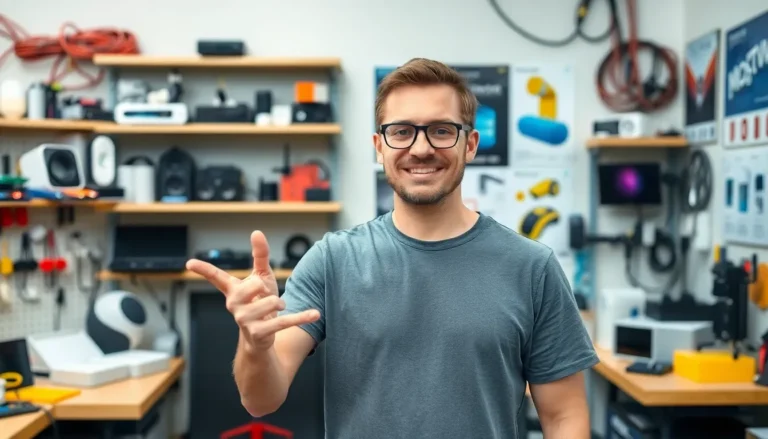Imagine a world where broken gadgets don’t end up in landfills but get a second chance at life. Welcome to the quirky realm of repair cafés! These community-driven havens are where skilled volunteers wield their tools like superheroes, ready to tackle everything from stubborn toasters to rebellious bicycles.
Table of Contents
ToggleWhat Are Repair Cafes?
Repair cafés are community spaces where skilled volunteers help fix broken items rather than discarding them. These cafés encourage sustainability while fostering community connections.
Origin and Purpose
Repair cafés originated in the Netherlands around 2009. They emerged from a desire to combat waste and promote a more sustainable lifestyle. Volunteers in these cafés focus on repairing items like electronics, textiles, and furniture. The primary aim centers on extending the life of products and reducing landfill waste. Community participation drives the movement, empowering individuals to learn new skills while making environmentally conscious choices.
Key Features
Repair cafés offer several distinct features that set them apart. First, knowledgeable volunteers provide hands-on assistance, ensuring participants can learn repair techniques. Second, repair sessions typically occur in an inclusive, welcoming environment. Participants bring various items, creating opportunities to socialize and share experiences. Third, tools and materials are generally available for free, which supports the repair process. Lastly, cafés often emphasize skill sharing; individuals leave with newfound knowledge and confidence in their ability to repair.
Benefits of Repair Cafes
Repair cafés offer numerous benefits that extend beyond simple repairs. Individuals engage in sustainable practices and foster community connections through these unique spaces.
Environmental Impact
Repair cafés significantly reduce waste and promote recycling. By extending the life of various items, they decrease the number of products that end up in landfills. Repairing electronics, textiles, and furniture helps lower the demand for new goods, reducing resource consumption. Estimates suggest that repairing a single item can save over 50% of the energy and materials required to produce a new one. Each repair contributes to a circular economy, where resources are reused rather than discarded. Participants learn about environmentally friendly practices and become more conscious of their consumption habits.
Community Building
Repair cafés foster strong community ties through collaboration and shared experiences. Individuals meet their neighbors while working on repairs, creating a sense of belonging. Volunteers share valuable skills, empowering others to tackle home repairs independently. Events often attract diverse groups, encouraging social interaction among people from different backgrounds and ages. The learning environment supports the transfer of knowledge, building a culture of sharing and cooperation. Participants develop friendships, enhancing social networks and support systems within the community.
How to Start a Repair Cafe
Starting a repair café involves organizing resources and engaging the community effectively.
Essential Equipment and Tools
Gathering essential equipment and tools creates a productive environment. Include basic hand tools, such as screwdrivers and pliers, as well as power tools and sewing machines for textile repairs. Worktables enable volunteers to work comfortably on various projects. Additionally, have safety equipment, like gloves and goggles, available for protection. Accessible electrical outlets ensure electronics can be repaired safely. Providing spare parts increases the chances of successfully fixing items. Establishing a designated area for tools helps maintain organization. Consider stockpiling materials for various repairs, such as fabric patches or wires. Prioritizing equitable access to resources encourages participation and fosters collaboration.
Finding Volunteers
Recruiting volunteers ensures a diverse skill set and community involvement. Utilize social media platforms and local bulletin boards for outreach. Engaging with local schools, universities, and trade organizations might attract skilled individuals interested in sharing their expertise. Hosting a kickoff event can generate interest, allowing potential volunteers to learn about the repair café’s mission. Emphasizing the benefits of volunteering, such as hands-on experience and community connection, can inspire more people to join. Building relationships with local businesses can provide access to tools and materials, bolstering volunteer engagement. Cultivating a welcoming atmosphere encourages ongoing participation and camaraderie among volunteers.
Success Stories
Repair cafés have successfully transformed communities by showcasing numerous inspiring stories. One notable example comes from a repair café in Amsterdam, where volunteers repaired over 500 gadgets in just one year. This success highlights the significant impact these cafés can have on reducing waste and fostering engagement.
A repair café in San Francisco emphasizes collaboration among locals. Here, attendees not only repair items but also share their skills. Participants have learned to fix bicycles, refurbish furniture, and mend clothing. Learning these skills enhances individual capabilities and promotes resourcefulness within the community.
In Melbourne, repair cafés have taken on a local twist. Over 600 residents have participated in events, turning repairs into community gatherings. These gatherings create social connections that strengthen neighborhood bonds. Participants often leave with repaired items and new friendships.
Another striking success comes from a repair café in London, which focuses on electronics. Volunteers fixed smartphones and laptops, reducing the volume of e-waste in landfills. This café demonstrated that skilled volunteers could tackle complex repairs and promote sustainable technology practices.
Data shows that repair cafés collectively save tons of materials each year. On average, each repaired item saves over 50% of the resources that new production consumes. This statistic underlines the contribution of repair cafés to the circular economy.
Repair cafés create lasting positive change, each story adding to their legacy. Communities unite through shared experiences, transforming waste into learning opportunities. With a focus on education and sustainability, these cafés continue to inspire individuals to engage in environmentally friendly practices.
Challenges Faced by Repair Cafes
Repair cafés encounter several challenges despite their positive contributions. Funding often represents a significant hurdle, as many rely on donations and volunteer labor to operate. Securing sustainable financial support proves essential for the long-term viability of these community spaces.
Volunteer recruitment can pose another issue. Many cafés rely on skilled individuals willing to donate time, but finding people with diverse repair skills isn’t always easy. Engaging local artisans and tradespeople plays a crucial role in building a robust skills base.
Space limitations affect operations in various cafés. Access to suitable venues generally depends on local partnerships and community support. Establishing relationships with businesses or public institutions can significantly alleviate this problem.
Awareness of repair cafés remains limited in many communities. Effective outreach strategies, including social media campaigns and local events, may increase public interest and participation. Connecting with schools and community organizations helps in spreading the message about repair services.
Safety and liability concerns frequently arise during repairs. Ensuring that volunteers adhere to safety protocols is vital to protect both them and participants. Implementing clear guidelines can mitigate risks associated with repairing electronic devices or using tools.
Educational barriers also exist. Some community members hesitate to participate due to a lack of confidence in their repair abilities. Offering workshops and skill-sharing sessions fosters an inclusive atmosphere that encourages learning and engagement.
Overall, repair cafés face a mix of operational and community-oriented challenges. Addressing these hurdles requires collaboration, commitment, and ongoing community support for enhancing sustainability and promoting circular economies.
Repair cafés represent a powerful movement towards sustainability and community engagement. By repairing rather than discarding, they not only reduce waste but also foster a sense of belonging among participants. These spaces empower individuals with practical skills while promoting environmentally conscious habits.
As more people discover the benefits of repair cafés, they can contribute to a circular economy that values resourcefulness and collaboration. With ongoing support and community involvement, repair cafés can thrive and continue to transform neighborhoods into hubs of creativity and sustainability. Engaging with this initiative can lead to a brighter future for both communities and the environment.






